Wood Stove
How To Run A Wood Stove

As the flames dance and sway vibrantly within the wood stove, I find solace in the warmth they radiate.
In this guide, I’ll show you the ins and outs of running a wood stove, ensuring a cozy and efficient experience.
From essential safety precautions to selecting the right wood and controlling the burn rate, you’ll become a master of this timeless heating method.
So, let’s dive in and unlock the secrets to running a wood stove with confidence and ease.
Key Takeaways
- Safety precautions such as having a fire extinguisher nearby and wearing heat-resistant gloves are essential when running a wood stove.
- Properly choosing and storing wood, including keeping it well-ventilated, off the ground, and seasoned, is crucial for efficient and safe operation.
- Lighting the fire correctly, using a pyramid shape arrangement of kindling and monitoring the fire closely, is important for a successful burn.
- Controlling the burn rate by adjusting the damper and regulating airflow is necessary to maximize efficiency and heat control.
Safety Precautions
I should always remember to follow safety precautions when operating a wood stove. Safety equipment is essential to protect myself and others from potential hazards.
Firstly, I must ensure that I have a fire extinguisher nearby in case of emergencies.
Additionally, wearing heat-resistant gloves is crucial to prevent burns when handling hot materials.
Installing a carbon monoxide detector near the wood stove is imperative as wood stoves can produce carbon monoxide, a colorless and odorless gas that can be deadly if inhaled in high concentrations.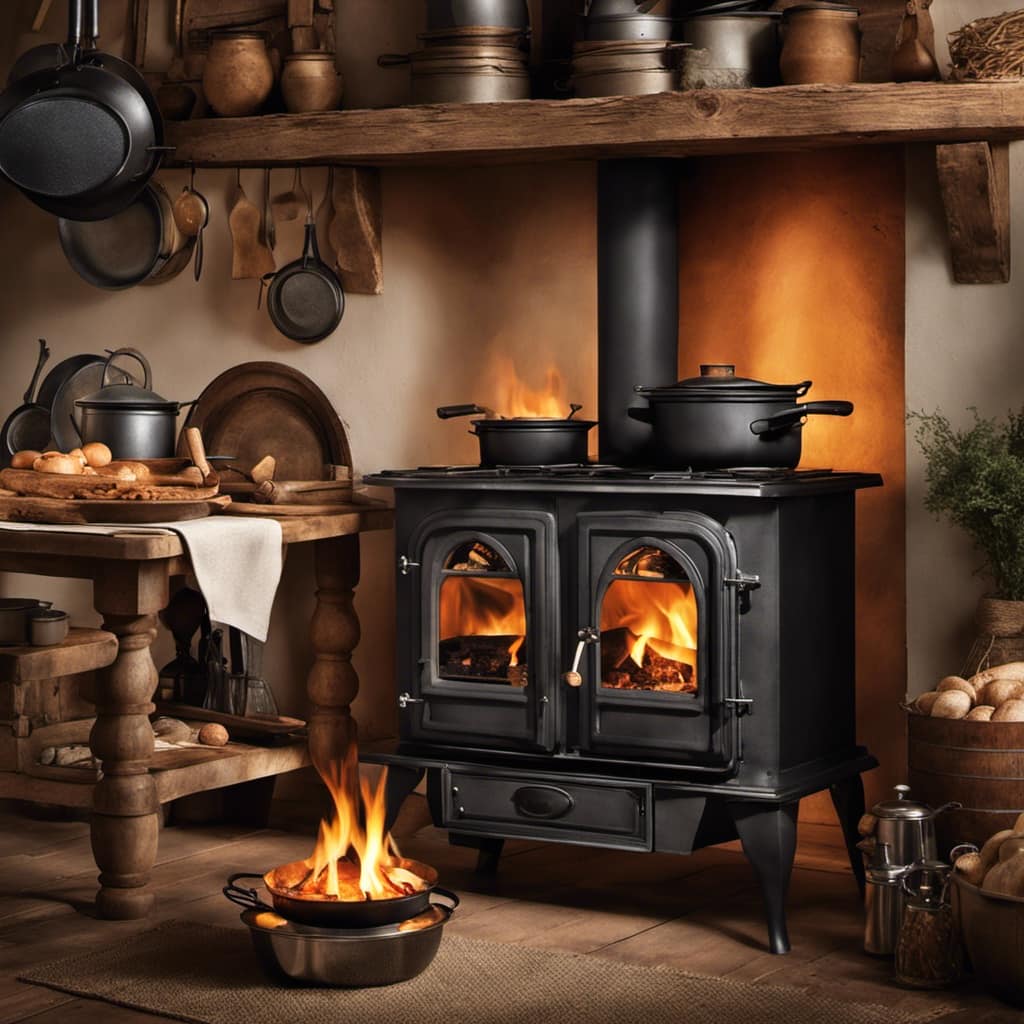
Regularly checking and cleaning the chimney is vital to prevent the buildup of creosote, which can pose a fire risk.
Lastly, keeping a safe distance from the stove and using a spark guard can prevent accidental burns and fires.
Choosing the Right Wood
To ensure optimal performance and efficiency, it’s important to select the right type of firewood for my wood stove. Proper wood storage and seasoning firewood are key factors in achieving this.
When it comes to proper wood storage, I make sure to keep my firewood stacked in a well-ventilated area, off the ground, and protected from rain or snow. This helps prevent moisture from seeping into the wood, which can make it difficult to ignite and create excessive smoke when burned.

Seasoning firewood is another crucial step. I allow the wood to dry for at least six months before using it in my wood stove. This process reduces the moisture content of the wood, making it burn more efficiently and produce less creosote buildup.
Now that the firewood is properly stored and seasoned, it’s time to move on to lighting the fire.
Lighting the Fire
Once the kindling is arranged in a pyramid shape, it’s important to carefully ignite it using a match or lighter. Before lighting the fire, ensure that the area around the stove is clear of any combustible materials. Make sure the damper is open to allow for proper airflow.
Once the fire is lit, monitor it closely to ensure it’s burning safely. Keep a fire extinguisher nearby in case of emergencies. If the fire is smoky, it may be an indication of poor airflow or damp wood. Adjust the damper or add more kindling to improve the burn.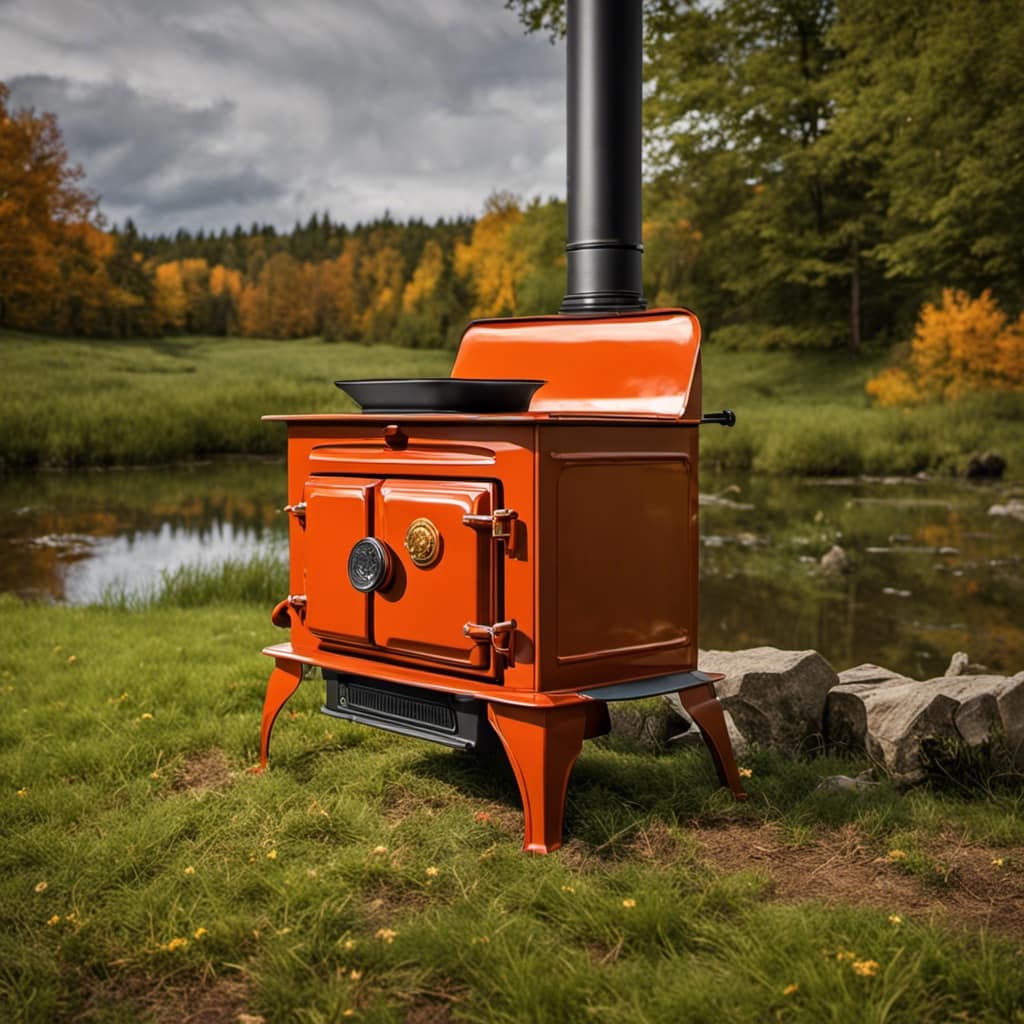
Remember to never leave the fire unattended and always practice proper fire safety.
Controlling the Burn Rate
Monitoring the airflow and adjusting the damper accordingly helps me control the burn rate of the fire. By regulating the amount of oxygen that enters the stove, I’m able to regulate the heat output and maximize efficiency.
The damper is a crucial component in this process, as it controls the airflow and determines the intensity of the fire. To increase the burn rate and heat output, I open the damper wider to allow more oxygen into the stove. Conversely, if I want to slow down the burn rate, I can partially close the damper to restrict the airflow. This level of control allows me to adjust the stove’s performance to suit my heating needs.
Now, let’s move on to the next section about cleaning and maintenance, which is essential for the stove’s longevity and efficiency.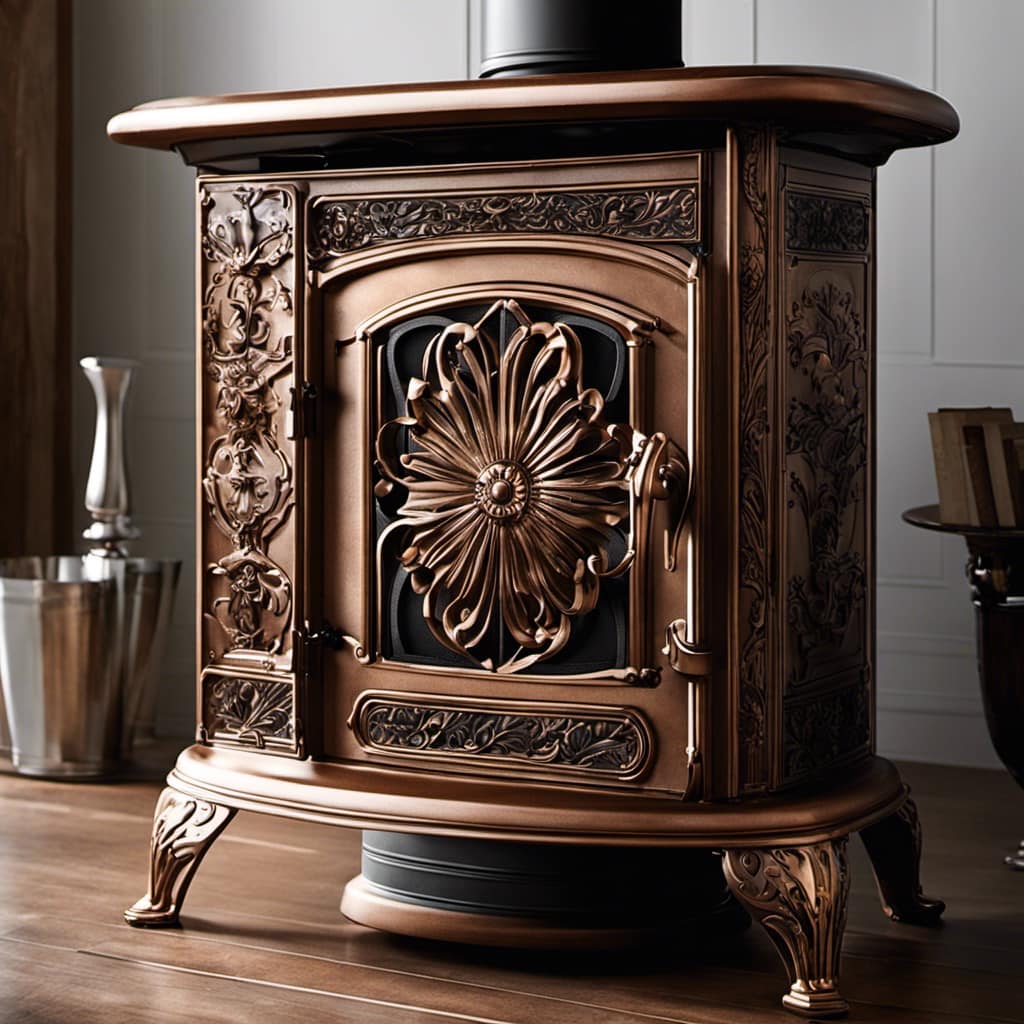
Can I Use My Wood Stove for Both Heating and Cooking?
Yes, you can use your wood stove for both heating and cooking. There are many resources online, including cooking on wood stove videos, that can provide tips and recipes for cooking on a wood stove. With proper precautions and knowledge, using a wood stove for cooking can be a versatile and efficient option.
Cleaning and Maintenance
When cleaning and maintaining my stove, I focus on removing any built-up ash and debris to ensure optimal performance.
One important aspect of maintenance is chimney cleaning. Over time, soot and creosote can accumulate in the chimney, leading to reduced airflow and increased risk of chimney fires. To clean the chimney, I use a chimney brush and extendable rod to scrub away the debris. It’s crucial to wear protective goggles and a dust mask during this process to prevent any particles from entering my eyes or lungs.
Another essential aspect of stove maintenance is ash disposal. I wait until the ash has cooled completely before removing it from the stove. Using a metal ash shovel, I carefully scoop out the ash and dispose of it in a metal container, away from any combustible materials.
Regular cleaning and maintenance ensure that my stove operates efficiently and safely.
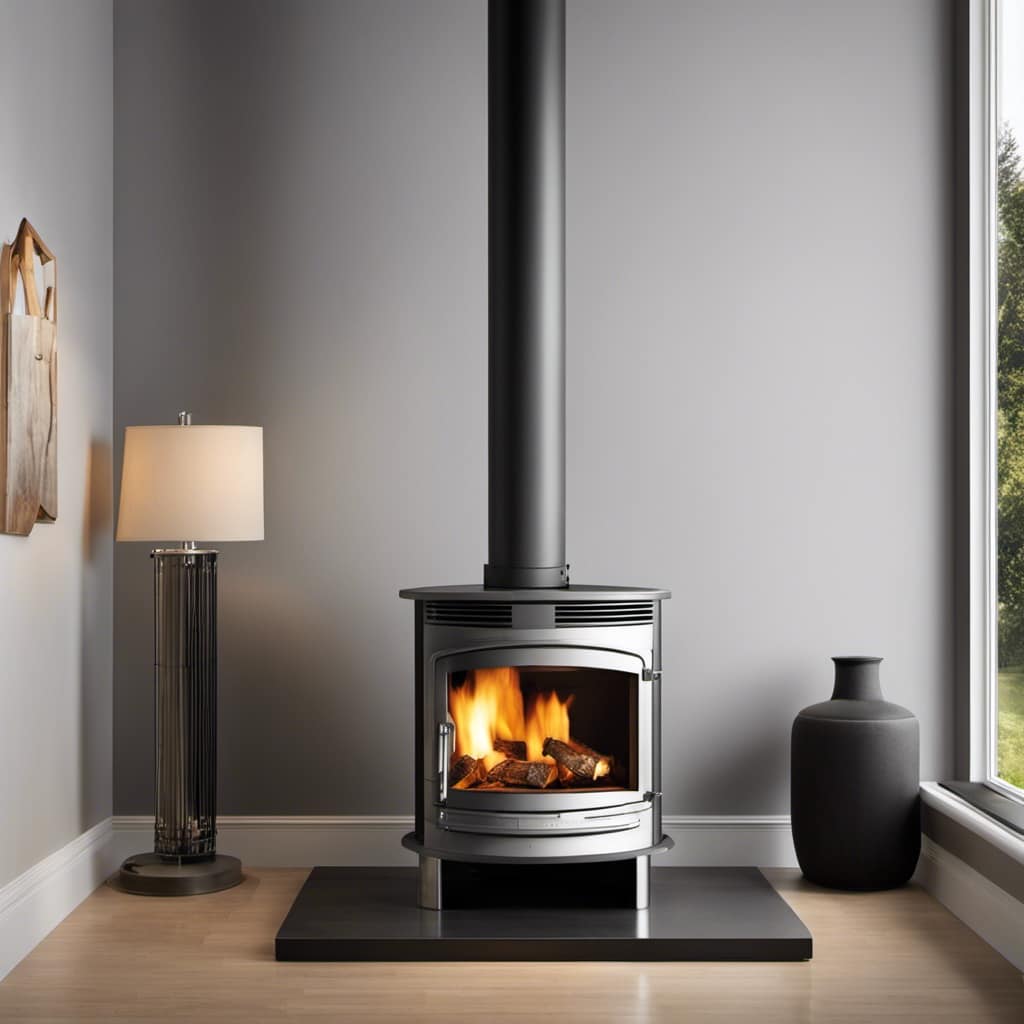
Frequently Asked Questions
How Do I Properly Season Firewood for My Wood Stove?
To properly season firewood for a wood stove, follow these best practices for stacking and storing: 1) Stack the wood in a single row, allowing for airflow. 2) Store the wood in a dry, well-ventilated area for at least 6-12 months.
What Are Some Common Mistakes to Avoid When Operating a Wood Stove?
When operating a wood stove, it’s crucial to avoid common mistakes. Improper airflow management can lead to inefficient burning, while using wet or unseasoned firewood can create excess smoke and lower heat output.
How Can I Prevent Creosote Buildup in My Chimney?
To prevent creosote buildup in my chimney, I ensure regular chimney cleaning and creosote removal. This involves removing any debris or obstructions, inspecting for damage, and using proper burning techniques to minimize creosote formation.
Can I Use Softwood in My Wood Stove?
Using softwood in a wood stove can lead to faster creosote buildup and less efficient burning. Hardwood, on the other hand, burns longer and produces more heat. Properly storing firewood is crucial for optimal burning efficiency.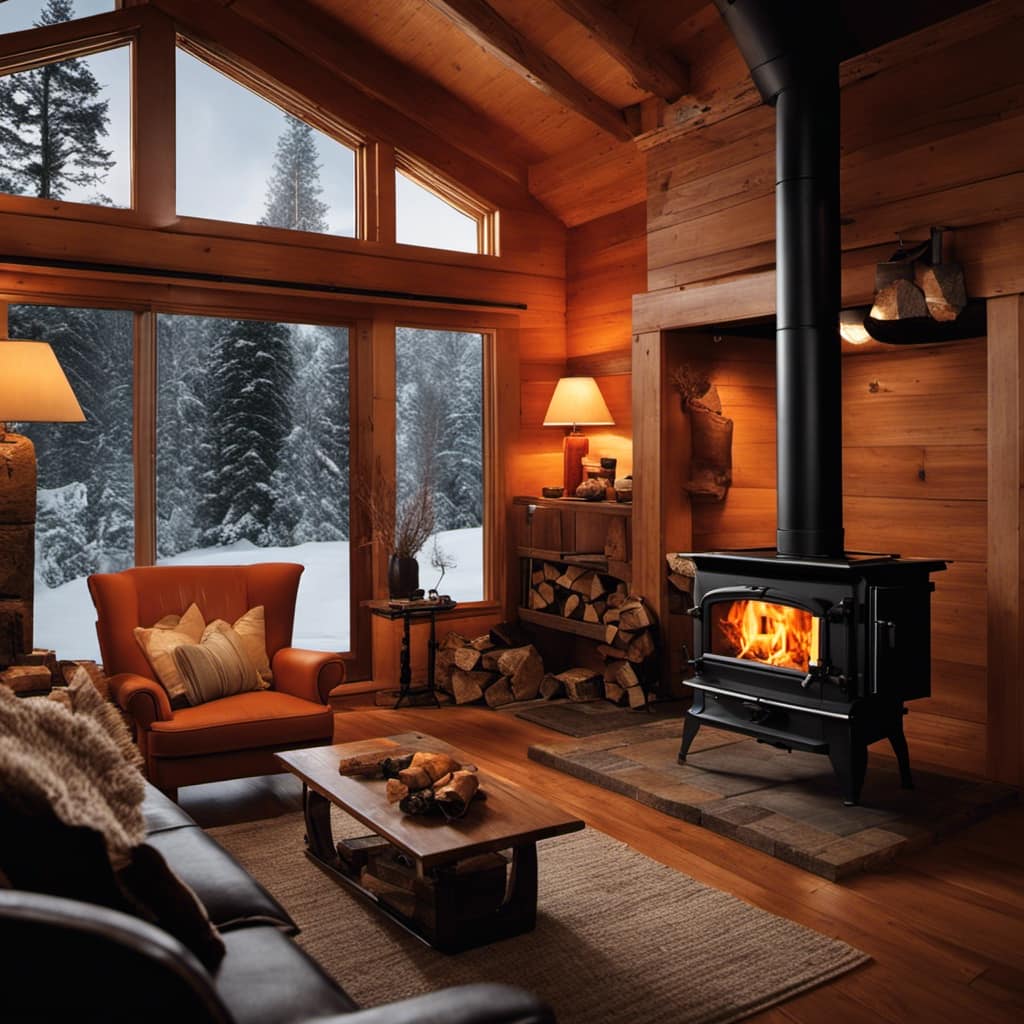
What Are Some Signs That My Wood Stove Needs Repairs or Servicing?
Some signs of wood stove problems include difficulty in starting a fire, excessive smoke or soot buildup, and irregular burning patterns. Regular maintenance is crucial to prevent these issues and ensure optimal stove performance.
Conclusion
In conclusion, running a wood stove requires careful attention to safety precautions, proper wood selection, and effective fire management.
By following these guidelines, you can create a warm and cozy atmosphere while ensuring the longevity and efficiency of your wood stove.
Remember to clean and maintain your stove regularly to prevent any potential hazards.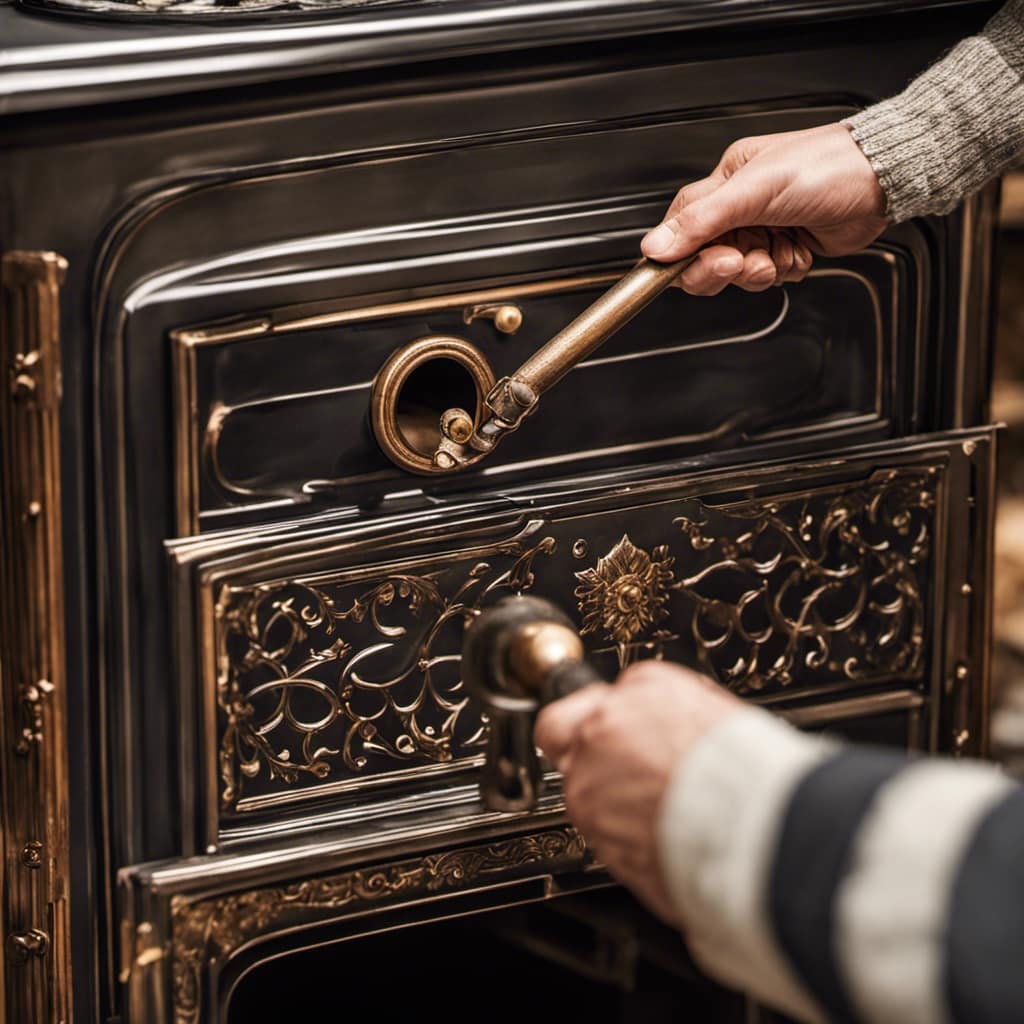
Embrace the comforting crackle of the fire and enjoy the natural warmth and ambiance it brings to your home.
Growing up surrounded by the vast beauty of nature, Sierra was always drawn to the call of the wild. While others sought the comfort of the familiar, she ventured out, embracing the unpredictable and finding stories in the heartbeat of nature.
At the epicenter of every remarkable venture lies a dynamic team—a fusion of diverse talents, visions, and passions. The essence of Best Small Wood Stoves is crafted and refined by such a trio: Sierra, Logan, and Terra. Their collective expertise has transformed the platform into a leading authority on small wood stoves, radiating warmth and knowledge in equal measure.
Wood Stove
How To Install A Flue On A Wood Stove
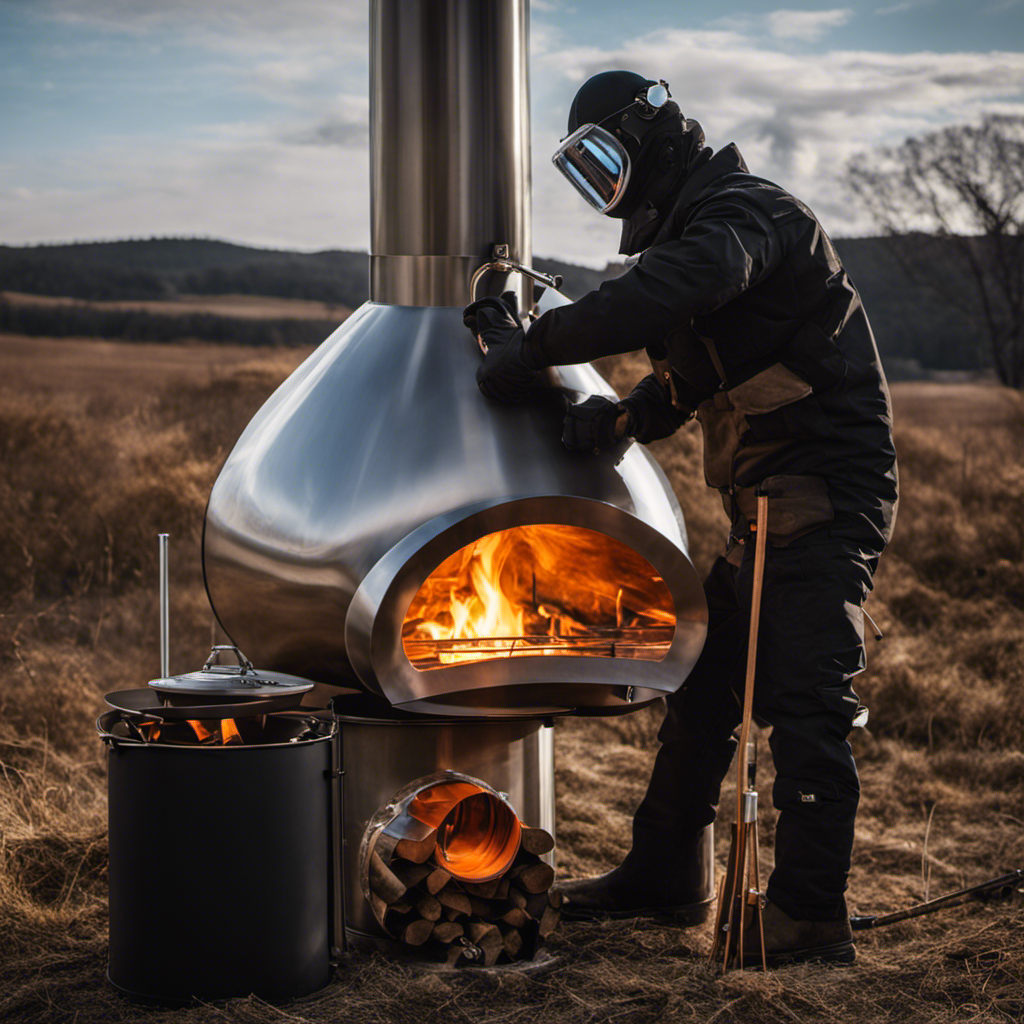
I’ve always held the conviction that the essence of a warm and inviting home lies in the presence of an operational wood stove.
And when it comes to installing a flue on that wood stove, it’s crucial to get it right. That’s why I’m here to guide you through the process, step by step.
From choosing the right flue to testing and maintaining the system, I’ll provide you with the technical knowledge and detailed instructions you need.
Let’s get started on creating a safe and efficient flue system for your wood stove.
Key Takeaways
- Flue size and material choice are crucial for efficiency and safety of the wood stove
- Consult manufacturer’s guidelines or professionals for correct flue size and material options
- Proper preparation of the wood stove, including cleaning and inspection, is necessary before flue installation
- Securely install the flue pipe and chimney cap to prevent debris and moisture entry
Choosing the Right Flue for Your Wood Stove
I’m having trouble deciding which flue is the right one for my wood stove. The size of the flue is an important consideration as it affects the efficiency and safety of the stove. The flue should be sized correctly to allow for proper airflow and to prevent the buildup of smoke and harmful gases. It’s important to consult the manufacturer’s guidelines or a professional to determine the appropriate flue size for your specific wood stove.
Additionally, there are various flue material options available, such as stainless steel, cast iron, or clay. Each material has its own advantages and considerations, including durability, insulation properties, and cost. Considering the flue size and material options will help ensure a successful installation.
Now that I understand the importance of choosing the right flue, it’s time to gather the necessary tools and materials.
Gathering the Necessary Tools and Materials
To properly install the flue, I’ll need a chimney brush and a ladder to clean out any debris. Once the chimney is clear, I can move on to selecting the right flue size. This is crucial for proper ventilation and efficient operation of the wood stove. Here are the steps I’ll follow:
- Measure the diameter of the stove’s flue collar.
- Determine the recommended flue size based on the stove manufacturer’s guidelines.
- Choose a flue that matches the stove’s requirements, ensuring a proper fit.
In addition to selecting the correct flue size, proper insulation is also essential. This helps prevent heat loss and ensures optimal performance. I’ll make sure to use high-quality insulation materials, such as ceramic fiber or rock wool, to insulate the flue properly.
Preparing the Wood Stove for Flue Installation
I’ll start by removing any debris and cleaning out the stove pipe before installing the flue. The first step in preparing the wood stove for flue installation is to ensure that the stove pipe is clear of any obstructions or build-up. This is crucial for the proper functioning of the flue system. I’ll carefully inspect the pipe to make sure there are no cracks or damages that could compromise its integrity.
Next, I’ll measure the diameter of the stove pipe to determine the correct sizing requirements for the flue. It’s important to choose a flue that matches the size of the stove pipe to ensure a tight and secure fit. Additionally, I’ll take all necessary safety precautions, such as wearing protective gloves and eyewear, to prevent any injuries during this process.
Now that the stove pipe is clean and the sizing requirements are determined, I can move on to installing the flue pipe and chimney cap.
Installing the Flue Pipe and Chimney Cap
I will carefully attach the flue pipe to the stove pipe, and then secure the chimney cap in place.
When installing the flue pipe, it’s crucial to follow proper procedures to ensure optimal chimney maintenance and prevent any potential issues with flue functionality. Here are three key steps to consider:
-
Align the flue pipe and stove pipe: Make sure the flue pipe is properly aligned with the stove pipe to ensure a secure fit. This will prevent any leaks or gaps that could affect the efficiency of the flue system.
-
Secure the connection: Use high-quality metal screws or clamps to secure the flue pipe to the stove pipe. This will ensure a tight and stable connection, minimizing the risk of any disconnection or movement during operation.
-
Install the chimney cap: The chimney cap plays a vital role in preventing debris, animals, and moisture from entering the flue system. Carefully install the chimney cap, ensuring it’s securely attached to the flue pipe.
By following these steps, you can effectively install the flue pipe and chimney cap, ensuring proper functionality and minimizing the need for troubleshooting flue issues.
Now, let’s move on to testing and maintaining the flue system for optimal performance.
Testing and Maintaining the Flue System
I’m regularly inspecting and cleaning the flue system to ensure its proper functioning and prevent any potential hazards.
Flue system troubleshooting is a crucial aspect of maintaining a safe and efficient wood stove. A poorly maintained flue can lead to a variety of problems, such as inadequate draft, excessive smoke, or even chimney fires.
Regular maintenance involves inspecting the flue pipe for any signs of damage or blockage, such as creosote buildup or debris. Additionally, it’s important to ensure that the flue damper is working correctly and fully opening and closing.
Cleaning the flue system involves removing any obstructions or debris using a chimney brush or professional cleaning tools.
Frequently Asked Questions
Can I Install a Flue on a Wood Stove Without Professional Help?
Yes, I can install a flue on a wood stove without professional help. It is important to have a good understanding of wood stove maintenance and follow the proper installation instructions for safety.
How Often Should I Clean My Flue System?
Regular flue maintenance is essential for the safe and efficient operation of your wood stove. You may be wondering how often you should clean your flue system. Let’s delve into the importance of regular maintenance.
Can I Use the Same Flue Pipe for Multiple Wood Stoves?
Yes, you can use the same flue pipe for multiple wood stoves, as long as the flue pipe is compatible with each stove. It is important to ensure proper installation and safety measures are followed.
Is It Necessary to Use High-Temperature Sealant When Installing the Flue Pipe?
Using high-temperature sealant when installing a flue pipe is crucial. Not using it can lead to potential risks like leaks, fire hazards, and inefficient stove performance. Explore alternative sealants, but prioritize safety.
Can I Use a Different Type of Chimney Cap for My Wood Stove?
Yes, you can use different chimney caps for your wood stove. There are alternative flue options available that can accommodate various types of caps, providing flexibility in design and functionality.
Conclusion
In conclusion, installing a flue on a wood stove is a technical and detailed process that requires the right tools and materials.
By choosing the appropriate flue, properly preparing the wood stove, and correctly installing the flue pipe and chimney cap, you can ensure the safe and efficient operation of your wood stove.
Regular testing and maintenance of the flue system will help to maintain its effectiveness and ensure a cozy and warm home.
Logan’s affair with adventure began in childhood. He hailed from a small town where vast forests bordered one side and endless shores stretched on the other. His days were spent exploring uncharted woods, climbing tall trees, or listening to the tales of old sailors. This early immersion in a world brimming with stories and mysteries became the foundation of his passion for writing.
Wood Stove
How Much Is A Discovery 2400 Wood Stove Worth
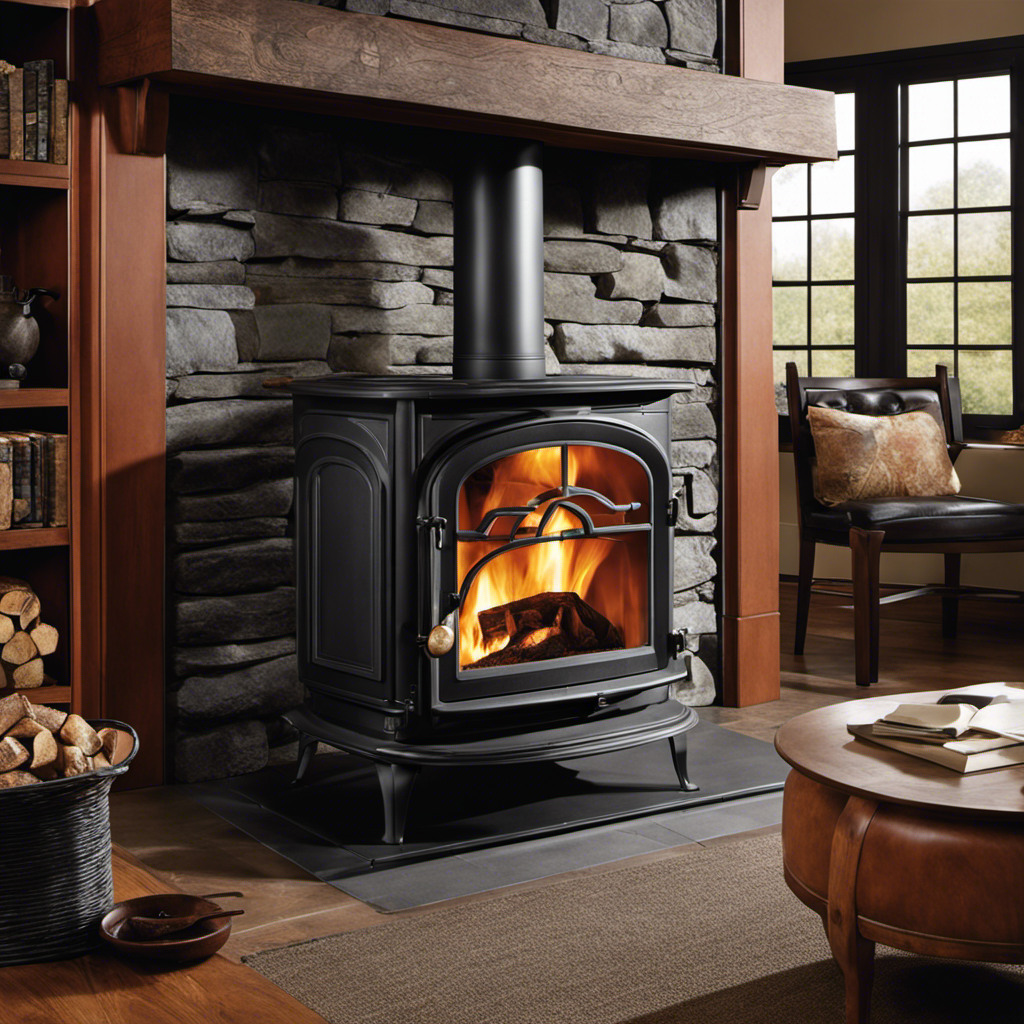
In my experience as a specialist in the realm of wood-burning stoves, I’ve encountered numerous styles. However, the Discovery 2400 consistently captures my attention. Its durability, efficiency, and classic design render it a valuable addition to any household.
Now, the burning question: how much is it worth? In this article, we will delve into the factors that affect the value of a Discovery 2400 wood stove, from market demand to evaluating its condition.
Get ready to uncover the appropriate price range for this exceptional wood stove.
Key Takeaways
- Popularity among wood stove enthusiasts and demand in the market are important factors affecting the value of a Discovery 2400 Wood Stove.
- The condition of the stove, including signs of wear and tear, functionality, and heat distribution, plays a significant role in determining its worth.
- Unique features or upgrades, as well as the age of the stove, can influence its value.
- Market demand for energy efficiency, environmental friendliness, durability, and reliability are increasing, leading to higher demand and quick sales of Discovery 2400 Wood Stoves.
Factors Affecting the Value of a Discovery 2400 Wood Stove
I’m considering selling my Discovery 2400 Wood Stove, so I’m curious about the factors affecting its value.
When it comes to resale value, there are several key factors to consider. First and foremost is the popularity among wood stove enthusiasts. The demand for a particular model can greatly impact its value in the market. The Discovery 2400 Wood Stove has gained a significant following due to its outstanding performance and efficiency.
Another factor to consider is the condition of the stove. A well-maintained and clean stove will fetch a higher price compared to one that shows signs of wear and tear. Additionally, any unique features or upgrades can also increase its value.
Lastly, the age of the stove plays a role, as newer models tend to have a higher resale value.
Taking all these factors into account will help determine the worth of your Discovery 2400 Wood Stove.
The Market Demand for Discovery 2400 Wood Stoves
There is a high demand for Discovery 2400 Wood Stoves, so they’re selling quickly in the market. As an experienced wood stove enthusiast, I’ve been closely following the market trends and consumer preferences surrounding these stoves. Here are some key points to consider:
-
Energy efficiency: Consumers are increasingly looking for wood stoves that aren’t only aesthetically pleasing but also energy-efficient. The Discovery 2400 Wood Stove checks both boxes, with its advanced combustion technology and high heat output.
-
Environmental friendliness: In line with the growing concern for the environment, the Discovery 2400 Wood Stove is designed to minimize emissions and promote clean burning. This feature resonates well with environmentally conscious consumers.
-
Durability and reliability: The market trends show that consumers value wood stoves that are built to last. The Discovery 2400 Wood Stove is constructed with high-quality materials, ensuring its durability and reliability for years to come.
Overall, the high demand for Discovery 2400 Wood Stoves can be attributed to its energy efficiency, environmental friendliness, and long-lasting performance. It’s no wonder these stoves are flying off the shelves!
Evaluating the Condition of a Discovery 2400 Wood Stove
After carefully inspecting the Discovery 2400 Wood Stove, I noticed that its exterior appears to be in excellent condition, and the stove door opens and closes smoothly.
When evaluating the condition of a wood stove, there are several criteria to consider. Firstly, it’s important to check for any signs of wear and tear, such as rust or dents. Additionally, the functionality of the stove should be assessed, including the efficiency of heat distribution and the performance of the stove’s components. These factors play a crucial role in determining the value of a wood stove.
Pricing considerations also come into play when evaluating a wood stove’s condition. The rarity of the model, the brand reputation, and the demand in the market can all impact the price. Therefore, a thorough assessment of the stove’s condition is necessary to make an accurate pricing decision.
Comparing Prices of Similar Wood Stoves in the Market
I’ve researched and compared the prices of similar wood stoves in the market, and I found that the Discovery 2400 Wood Stove is competitively priced.
When comparing features, the Discovery 2400 stands out with its efficient heating capabilities and durable construction. It’s equipped with a powerful blower that ensures even distribution of heat throughout the room. Additionally, this wood stove has a large viewing window, allowing you to enjoy the mesmerizing flames while keeping warm.
When comparing customer reviews, the Discovery 2400 consistently receives positive feedback for its performance and reliability. Customers appreciate its ease of use and the long burn times it offers.
Overall, the Discovery 2400 Wood Stove provides excellent value for its price, making it a top choice for those in search of an affordable and high-quality wood stove.
Determining the Appropriate Price Range for a Discovery 2400 Wood Stove
Based on market research and customer feedback, I believe the appropriate price range for a Discovery 2400 Wood Stove would be between $1,500 and $2,000. When determining the value of a wood stove, there are several factors that can affect its appraisal. These factors include the brand reputation, condition, age, and features of the stove. To accurately assess the value of a Discovery 2400 Wood Stove, it is important to research historical sales of similar models. This data will provide insights into the market demand and the average selling price of these stoves. By considering these factors and conducting thorough research, we can establish an appropriate price range that reflects the true value of the Discovery 2400 Wood Stove.
| Features | Condition | Age | Price Range |
|---|---|---|---|
| High Quality | Excellent | 5 | $1,500-$2,000 |
| Versatile | Good | 7 | $1,200-$1,600 |
| Efficient | Fair | 10 | $800-$1,200 |
| Stylish Design | Poor | 12 | $500-$800 |
Frequently Asked Questions
How Long Does a Discovery 2400 Wood Stove Typically Last?
Typically, a Discovery 2400 wood stove can last for many years with proper cleaning and maintenance. Regularly cleaning the stove and chimney, as well as inspecting and replacing any worn parts, can extend its lifespan.
What Are the Maintenance Requirements for a Discovery 2400 Wood Stove?
Maintaining a Discovery 2400 wood stove is crucial for optimal performance. Regular cleaning and inspection of the chimney, flue, and air vents are essential. A case study shows that neglecting maintenance can lead to costly repairs.
Are There Any Safety Concerns or Precautions to Consider When Using a Discovery 2400 Wood Stove?
When using a Discovery 2400 wood stove, it is crucial to consider safety concerns and take necessary precautions. This includes proper ventilation, regular maintenance, and following the manufacturer’s guidelines to prevent accidents and ensure safe operation.
Can the Discovery 2400 Wood Stove Be Used for Heating Purposes Only, or Can It Also Be Used for Cooking?
Yes, the Discovery 2400 wood stove can be used for both heating and cooking. It’s a versatile appliance that not only warms your space efficiently but also allows you to prepare delicious meals with the comforting heat of a real wood fire.
Is It Possible to Convert a Discovery 2400 Wood Stove to a Different Fuel Source, Such as Gas or Pellets?
Converting a Discovery 2400 wood stove to a different fuel source, like gas or pellets, is possible. However, it’s important to consider the pros and cons of such a conversion before making a decision.
Conclusion
After considering the various factors that affect the value of a Discovery 2400 Wood Stove, such as market demand and condition, it’s clear that determining its worth can be a complex task.
However, by comparing prices of similar wood stoves in the market and conducting a thorough evaluation, one can establish an appropriate price range.
Ultimately, the value of a Discovery 2400 Wood Stove lies in its functionality, condition, and the demand for such stoves in the market.
Growing up surrounded by the vast beauty of nature, Sierra was always drawn to the call of the wild. While others sought the comfort of the familiar, she ventured out, embracing the unpredictable and finding stories in the heartbeat of nature.
At the epicenter of every remarkable venture lies a dynamic team—a fusion of diverse talents, visions, and passions. The essence of Best Small Wood Stoves is crafted and refined by such a trio: Sierra, Logan, and Terra. Their collective expertise has transformed the platform into a leading authority on small wood stoves, radiating warmth and knowledge in equal measure.
Wood Stove
How Do You Move A 500 Lb Wood Stove
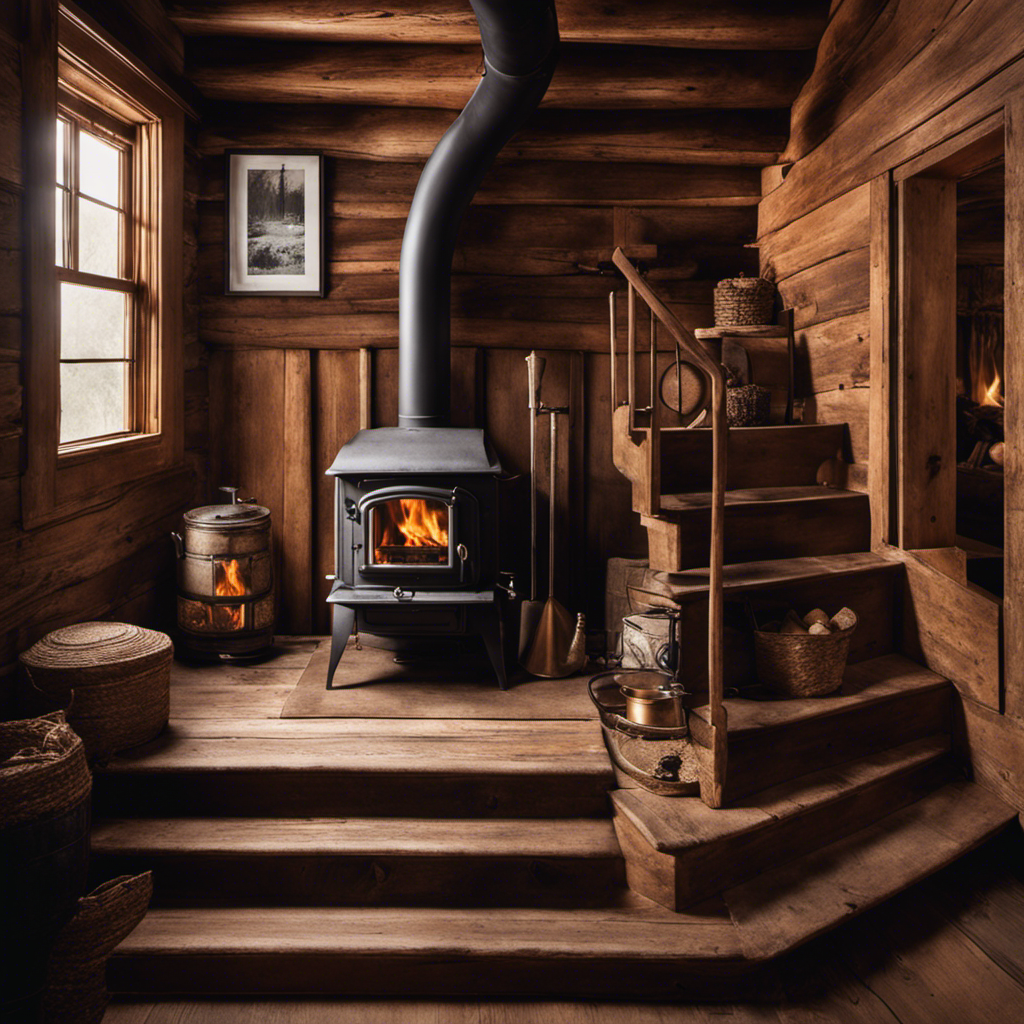
Have you ever considered the formidable challenge of relocating a 500-pound wood-burning stove? Well, I’m here to inform you that it’s no small feat! However, don’t worry. I have compiled a comprehensive guide, detailing every step, to help you with this task.
From assessing the weight and size of the stove to gathering the necessary equipment and tools, I’ll walk you through the whole process.
So, grab your gloves and get ready to flex those muscles – we’re about to make moving a wood stove a breeze!
Key Takeaways
- Assess the structural integrity of the wood stove before moving it
- Use appropriate lifting equipment and tools to safely transport the stove
- Prepare the area and ensure safety by clearing obstacles and securing the surroundings
- Follow proper lifting techniques and take breaks to prevent injuries and fatigue
Assessing the Weight and Size of the Wood Stove
I just measured the weight and size of the wood stove, and it’s definitely heavier than I expected. Evaluating the structural integrity of the stove is essential before attempting to move it. This involves checking for any cracks, loose parts, or weakened areas that could compromise its stability during the move.
Once the stove’s condition has been assessed, it’s important to determine the appropriate moving technique. For a heavy stove like this, it’s crucial to have a plan in place to ensure a safe and successful move. This could involve using furniture sliders, a dolly, or enlisting the help of additional people.
Gathering the Necessary Equipment and Tools
To safely transport the wood stove, it’s important to gather both the proper equipment and tools. Here are four essential items you’ll need:
-
Choosing the right lifting straps: Make sure to select lifting straps that are strong and durable enough to support the weight of the wood stove. Look for straps with a high weight capacity and secure fastening mechanisms.
-
Using a furniture dolly: A furniture dolly is an excellent tool for moving heavy objects like a wood stove. Make sure the dolly is sturdy and has a weight capacity that can handle the stove’s weight. Secure the stove onto the dolly using straps or ropes for added stability.
-
Moving blankets or padding: Protecting the wood stove during transport is crucial to avoid any damages. Wrap the stove with moving blankets or padding to prevent scratches or dents.
-
Gloves and safety goggles: It’s essential to protect yourself during the moving process. Wear gloves to provide a better grip and protect your hands from any sharp edges. Safety goggles will protect your eyes from any debris or dust.
By gathering these necessary equipment and tools, you’ll be well-prepared to safely transport your wood stove.
Now, let’s move on to preparing the area and ensuring safety for the next steps.
Preparing the Area and Ensuring Safety
Before starting the process, make sure to clear out any obstacles and secure the area to ensure safety.
Ensuring stability and protecting the surrounding area are crucial steps when moving a 500 lb wood stove.
Begin by removing any furniture or objects that may hinder your path.
Make sure the floor is clean and free of debris to avoid slips or falls.
Next, secure the surrounding area by using furniture sliders or plywood sheets to protect the flooring from scratches or damage.
It’s also essential to have a clear path and ample space for maneuvering the stove.
Once the area is prepared, you can proceed with lifting and moving the wood stove, which we’ll discuss in the next section.
Lifting and Moving the Wood Stove
Moving the heavy wood stove requires proper lifting technique and a sturdy dolly. When attempting to lift the stove, it’s important to follow these lifting techniques to minimize potential risks:
- Bend your knees and keep your back straight to avoid straining your back muscles.
- Use your leg muscles to lift the stove, rather than relying on your back.
- Lift with a partner to evenly distribute the weight and prevent accidents.
- Take breaks and avoid overexertion to prevent fatigue and reduce the risk of injury.
By following these lifting techniques, you can ensure a safe and successful move of the wood stove.
Now, let’s discuss how to secure and position the wood stove in its new location.
Securing and Positioning the Wood Stove in Its New Location
I’ll make sure to anchor the wood stove securely in its new location to prevent any accidents. Securing the wood stove is crucial to ensure that it stays in place and doesn’t pose any risks.
One of the most effective securing techniques is to use anchor bolts. These bolts are drilled into the floor or the wall behind the stove and provide a strong hold. It’s important to choose the right size and type of anchor bolts suitable for the weight and dimensions of your wood stove.
Additionally, proper positioning is essential for the stove’s performance and safety. Make sure to leave enough space around the stove for ventilation and easy access for maintenance. Also, consider placing it on a non-combustible surface to minimize fire hazards.
Frequently Asked Questions
How Much Does a Typical 500 Lb Wood Stove Cost?
Typically, the cost of a 500 lb wood stove ranges from $1000 to $3000, depending on the brand and features. Some of the best brands known for quality wood stoves include Vermont Castings, Jotul, and Hearthstone.
Can I Move a 500 Lb Wood Stove by Myself?
I can move a 500 lb wood stove by myself, but it’s not recommended. It’s safer to use moving equipment like dollies or hire professionals who specialize in moving heavy items.
What Are the Common Mistakes to Avoid When Moving a Wood Stove?
When moving a wood stove, it’s important to avoid common mistakes. Use moving equipment like dollies or sliders to ease the process. Remember to employ proper lifting techniques to prevent injury.
Are There Any Special Considerations for Moving a Wood Stove up or Down a Flight of Stairs?
Moving a wood stove upstairs requires careful planning and safety precautions. Protecting the stove and preventing damage is crucial. Start by assessing the weight and dimensions of the stove, and use proper lifting techniques to avoid injury.
How Often Should a Wood Stove Be Professionally Inspected and Serviced?
I recommend having a professional inspect and service your wood stove annually. Regular maintenance ensures optimal performance, reduces the risk of chimney fires, and prolongs the lifespan of the stove. DIY inspections may miss potential issues.
Conclusion
Moving a 500 lb wood stove may seem like a daunting task, but with the right equipment and precautions, it can be accomplished safely. By assessing the weight and size of the stove, gathering the necessary tools, and preparing the area, you can ensure a smooth and successful move.
Remember to lift with your legs and not your back, and use straps or dollies to assist in the process. With careful planning and execution, you’ll have your wood stove in its new location in no time, ready to provide warmth and comfort.
Logan’s affair with adventure began in childhood. He hailed from a small town where vast forests bordered one side and endless shores stretched on the other. His days were spent exploring uncharted woods, climbing tall trees, or listening to the tales of old sailors. This early immersion in a world brimming with stories and mysteries became the foundation of his passion for writing.
-

 Wood Stove4 weeks ago
Wood Stove4 weeks agoWhen To Open And Close Damper On Wood Stove
-

 Wood Stove3 weeks ago
Wood Stove3 weeks agoHow To Build A Thermoelectric Generator For A Wood Stove
-

 Wood Stove4 weeks ago
Wood Stove4 weeks agoHow To Use Damper And Draft On Wood Stove
-

 Wood Stove3 weeks ago
Wood Stove3 weeks agoHow Does A Circulator Wood Stove Work
-

 Pellet Stoves2 days ago
Pellet Stoves2 days agoWhy Is My Wood Pellet Stove Putting so Much Soot
-

 Wood Stove3 weeks ago
Wood Stove3 weeks agoHow Far Does Wood Stove Have To Be From Wall
-

 Wood Stove4 weeks ago
Wood Stove4 weeks agoWhat Can I Use As Insulation On Wood Stove Pipes
-

 Pellet Stoves4 days ago
Pellet Stoves4 days agoHow to Make a Pellet Basket for Wood Burning Stoves








